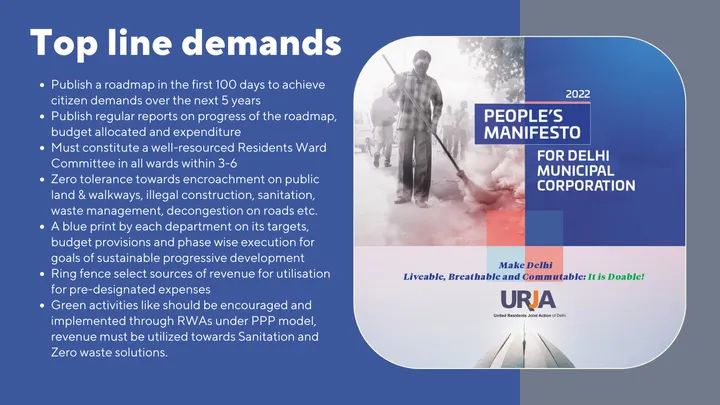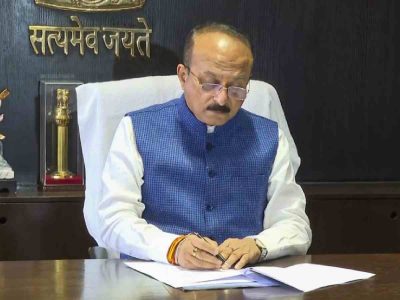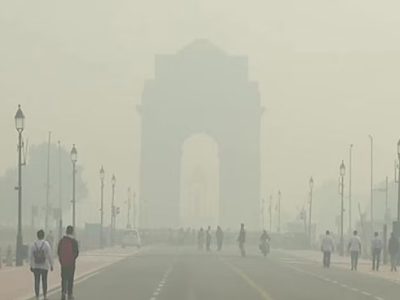While the ruling Bharatiya Janata Party (BJP) and its rivals Aam Aadmi Party (AAP) and Congress are busy wooing voters, Delhi’s citizens listed their own demands under a ‘People’s Manifesto’.
The United Residents Joint Action (URJA), a consortium of more than 2500 resident welfare associations (RWAs) in Delhi, issued a charter of demands for a “liveable, breathable and commutable” city.
The manifesto includes seven demands, 12 goals and provides solutions to achieve them. It demands that the MCD should publish a roadmap in the first 100 days of new councillors assuming office, with measurable, time-bound and ward-specific goals to achieve citizen demands over the next five years.
“This helps in providing direction to each department, the residents and other agencies in Delhi to accordingly evaluate the soundness of the plan and align themselves with it,” it said.
Highlighting the need for change in the administration of local bodies, the president of URJA, Atul Goyal said that a change of leadership is always welcome, notwithstanding how political parties more or less work in the same “lackadaisical manner” upon assuming office.
Top-line demands
Ahead of the MCD elections, the RWAs want elected councillors to pledge action on key issues. “Publish a roadmap in the first 100 days to achieve citizen-specific demands over the next 5 years with measurable, time-bound and ward-specific goals,” the manifesto states.
Following this, the corporation is expected to publish regular reports on the progress of the roadmap, budget allocated and expenditure, as well as conduct a publicly available performance audit by the Comptroller & Auditor General (C&AG) and constitute a well-resourced Residents Ward Committee in all wards within 3-6 weeks.
This, the URJA said, helps to know which MCD department is experiencing a shortage of resources and which department is under-utilising the allocated budget leading to gaps in service delivery.
“Transparency also helps understand if the annual budget allocation is in line with the increasing population and changing characteristics of each ward. Ring-fence select sources of revenue for utilisation for pre-designated expenses,” the umbrella body said.
“Each department of the MCD has a certain amount of grants and funds for the execution of its duties. What we have observed during the study is whatever fund is being allocated to these departments, they fail to utilise that amount. It’s either a lack of human resources or corruption. So, how do we overcome this? Only an audit by the C&AG within each department and the corporation as a whole can help plug these holes,” he said.
While the parties have made sanitation, landfills the primary poll plank, the RWAs have asked for zero tolerance towards encroachment on public land and walkways, illegal construction, sanitation, waste management and decongestion on roads.

Further, according to the People’s Manifesto, a blueprint should be released by each department regarding its targets, budget provisions and phase-wise execution of goals for sustainable development.
“The corporation must encourage green activities and implement those through RWAs under PPP (public-private partnership) model, revenue must be utilised towards sanitation and zero waste solutions,” it said.
In the wake of the financial crisis plaguing MCD over the last decade, URJA has demanded a clear blueprint of the budgetary requirement of each municipal department along with available funds and a way forward to fill the gap.
“Parties should provide a mechanism to involve citizens and RWAs while presenting a mechanism of accountability and a review process for the MCD,” the manifesto said.
“Ring-fencing of sources of revenue should be carried out for utilisation for pre-designated expenses; for example tax collection from vehicles should only be utilised for improving public transport,” it added.
Sanitation, Pollution and Roadways
The manifesto calls for joint-monitoring committees on sanitation, a roadmap to ensure a yearly reduction of landfills and ward-level centres to collect and process different types of waste.
Additionally, it demanded that monitoring groups at the ward-level, in the form of ‘Nagrik Safayi Nigrani Samitis (NSNS)’, should be constituted with the participation of local councillors, RWAs and market associations, to monitor the waste management and sanitation services.
The purpose of the NSNS would be to “bring citizens on board at ward level to work with the municipal authority for cleaning their own areas”.
“This will make the RWAs and citizens responsible for their own mess. In every ward, there will be sanitation warriors and the RWAs monitor sanitation purposefully and more accountability will be established,” URJA president said.
“The RWAs should be responsible for the local safai because they do have the manpower. A certain amount of revenue should be transferred to perform these services, such as sanitation and parking management by the corporation as the people are directly affected by it,” he added.
In view of the rising air pollution, URJA has urged for mapping areas that generate dust. “Keep dug-up spaces and construction sites covered with mist spraying when AQI levels soar. Information on the construction agency and client should be displayed on a board at every construction site. Deploy road dust-cleaners suitable to various road sizes,” it said.
“To avoid repeated digging of roads, the manifesto has demanded an Open Duct Policy in all parts of Delhi,” it said.
An open or common duct policy could reduce the operational cost of firms, remove roadway challenges, while eliminating the need for frequent digging up of roads. It refers to a common structure installed underground for public utilities ranging from electric and communication cables to water, sewage and gas pipelines. The Open or Common Duct Policy calls for an overground structure for housing public utilities and usually includes a ‘smart pole’.
Green Cover
In the solution-oriented manifesto, URJA laid out a list of plans that the corporation could use to protect and preserve the national capital’s precious forest and green cover.
These include a demand to increase canopy cover, native tree species and mandatory green cover on rooftops of large buildings.
Elaborating on the roof-top green cover, Goyal underlined that it could be a game changer in bringing some respite from the hazardous smog.
“The rooftops of high-rise buildings in Delhi are all mostly abandoned so why not use the space to create greenery? This could expand the city’s green cover and also naturally help in fighting air pollution. The government should come up with a rule that says that a certain amount of greenery must be in these rooftops. Particularly in the industrial area, the roofs are all full of garbage so instead of that why not grow plants,” he asked.
Besides, the RWAs have demanded 100 metres on either side of all drains and rivers to be declared as ‘green belts’. “There should be a minimum green cover requirement for institutional and industrial areas. The MCD should plant native species on central verges, sidewalks,” the RWAs’ body said.
“Beyond these issues, we face serious budgetary constraints so the corporation should transfer funds to us to manage our own problems. We should be entrusted with green activities, local area parking management, composting and cleanliness, which will help the environment and at the same time create a sense of belonging and ownership. Currently, that feeling is not there – the MCD is relied upon for everything,” Goyal concluded.
Follow us on:
Instagram: instagram.com/thepatriot_in/
Twitter: twitter.com/Patriot_Delhi
Facebook: facebook.com/Thepatriotnewsindia





